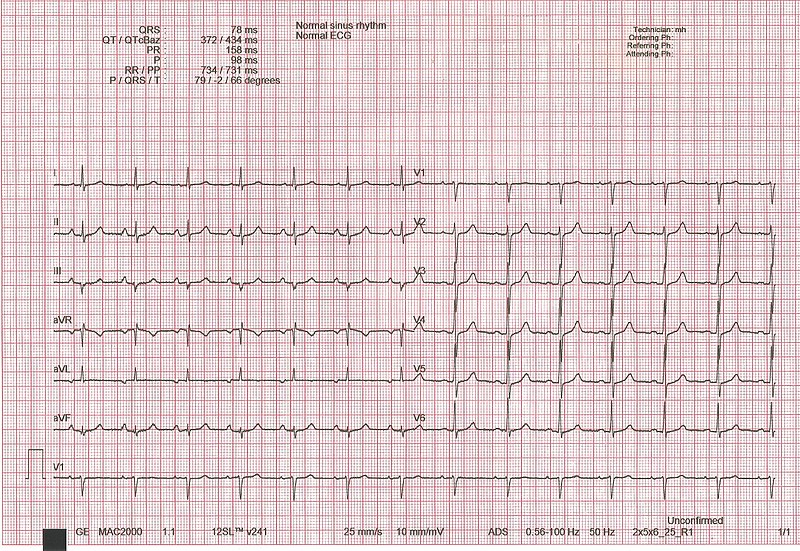Playlist
Show Playlist
Hide Playlist
Cardiac Action Potential
-
Slides Learning to Read an ECG.pdf
-
Reference List Electrocardiogram (ECG) Interpretation.pdf
-
Download Lecture Overview
00:01 So let's go through the electrical activity in the heart. 00:04 So, when a myocardial cell depolarizes; that is it has a resting potential electric current across its membrane, and then suddenly that goes to zero. 00:15 When that happens in a process called the action potential it results in a trigger of the myocardial contractile machinery. 00:24 So you have the electrical depolarization, contraction, electrical depolarization, contraction. 00:30 So, there is a pacemaker which spontaneously depolarizes high in the right atrium. 00:37 That's the little round green dot high in the right atrium in the diagram on the left here. 00:44 And that area has very specialized myocardial cells. They depolarized spontaneously. 00:52 Sodium spontaneously leaks into the cell through some channels that are called the funny channels cuz no other sodium channel leaks like this. 01:02 And when they get to a certain point, it triggers the action potential. 01:06 And then what happens is the wave of electrical depolarization passes from the sinus node through the atria down into the septum of the - between the two ventricles. 01:19 There's a pause at the AV node and that's the second little round green circle. Why a pause? Because if it went immediately into the ventricle, both the atria and the ventricle will be contracting at the same time. 01:32 Not a good idea because then nothing would go off the aorta, there would be no effective cardiac output. 01:39 So there's a pause while the atria finishes its contraction, filling the ventricles. 01:46 And then the way the depolarization passes down, past the AV node into the His-Purkinje system and throughout the ventricle, passing down first the septum to the apex and then backwards to the base of the heart. 02:01 And when that happens, it triggers contraction and the ventricles squeezes. 02:06 And here you see - here's a whole series of action potentials for the different myocardial cells as the wave of depolarization passes down. 02:15 This is the - you'll see the action potential for the sinus node which is as you can see slowly rising. 02:25 There's a spontaneous depolarization. 02:27 But once you get into the atria and to the ventricle, the depolarization is not spontaneous, it's immediate as the wave of depolarization arrives. 02:36 And so - then here we see again going down through the atrium and into the - past the mitral valve, past the tricuspid valve into the ventricle, you're in the His-Purkinje system now. 02:49 And then eventually, you finish and you get to the T wave as everything resets itself, getting ready for the next beat. 02:58 It's interesting that the wave of depolarization doesn't go through the ventricle all at the same place. 03:07 It comes down the septum, arrives at the apex and then turns back and does the base. 03:13 So what that means is that if you're an observer - you're an electrode watching this, when the electrical current and the wave of depolarization is coming towards you, the EKG records an upstroke. 03:27 When the electrical depolarization passes the apex and starts to go back towards the base, in other words going away from an electrode, you see a negative deflection. 03:37 And that's why for example, you saw on the QRS, there's some positive and there's some negative depending on where the electrode is looking. 03:45 If an electrode's looking from here, it's going to see different than if the electrode's looking from here because the way the depolarization from here will be coming towards this one at a certain point when it's going away from the one over here and vice versa. 03:59 And we'll see some examples of that. 04:01 And here in the -- we continue -- we see the wave of depolarization passing from the apex back up to the base until the entire - both right and left ventricle have depolarized and have contracted.
About the Lecture
The lecture Cardiac Action Potential by Joseph Alpert, MD is from the course Electrocardiogram (ECG) Interpretation.
Included Quiz Questions
Which of the following is the normal pacemaker of the heart?
- The SA node
- The AV node
- The Purkinje fibers
- The Bachmann bundle
- The bundle of His
Which of the following describes the electrical conduction pathway of the heart?
- SA node → atrium → AV node → His–Purkinje system → ventricles
- SA node → AV node → atrium → His–Purkinje system → ventricles
- SA node → atrium → AV node → ventricles → His–Purkinje system
- AV node → SA node → atrium → His–Purkinje system → ventricles
- AV node → atrium → SA node → His–Purkinje system → ventricles
Customer reviews
4,5 of 5 stars
| 5 Stars |
|
1 |
| 4 Stars |
|
1 |
| 3 Stars |
|
0 |
| 2 Stars |
|
0 |
| 1 Star |
|
0 |
Very clear! Super easy to understand and made to not be complicated
Very good summary of the cardiac action potential, did not get into the little details, but I think that's fine considering this is not meant to be a masterclass on cardiac cell electrophysiology.




